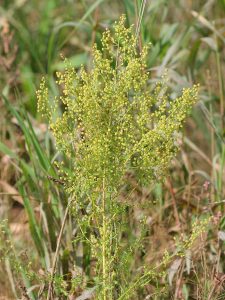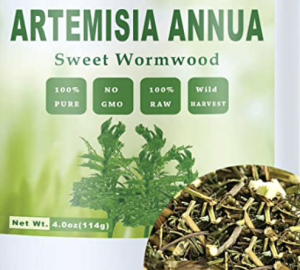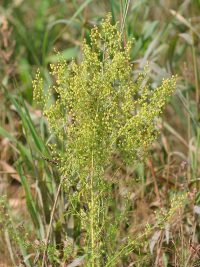
Sweet wormwood, also known as Artemisia annua, is a medicinal plant that has been used for centuries in traditional Chinese medicine. This green herb is native to Southeast Asia and is recognized for its feathery leaves and yellow flowers. The plant has a variety of therapeutic properties, and it has been used to treat malaria, fevers, viral and bacterial infections, as well as inflammation. It has been called a plant version of ivermectin that has strong antiviral, anti-parasitic, anti-inflammatory properties.
Sweet wormwood has been traditionally used in Chinese medicine to treat various illnesses, including fever. The active ingredient in sweet wormwood is a compound called artemisinin, which was first isolated from the plant in 1972. Artemisinin is a potent antimalarial agent, and it has been recommended by the World Health Organization as a first-line treatment for malaria. The use of artemisinin in the treatment of malaria has been successful, leading to a significant reduction in mortality rates due to the disease. In 2015, artemisinin was awarded half of the Nobel Prize in Physiology or Medicine for its success in treating malaria.
Interestingly, artemisinin has some similarities to another Nobel Prize-winning drug, ivermectin. Ivermectin is derived from a bacterium through a manmade process and is used to treat a range of parasitic infections. In 2015, ivermectin was awarded the other half of the Nobel Prize in Physiology or Medicine for its success in treating roundworm infections. Ivermectin has also been used to treat other parasitic infections, such as scabies and head lice.
Success against many viruses
Artemisinin and its derivatives have been found to have antiviral activity against a variety of viruses, including the human immunodeficiency virus (HIV), hepatitis B virus (HBV), and influenza A virus. The exact mechanism by which artemisinin and its derivatives exert their antiviral effects is not fully understood, but it is believed to involve multiple pathways.
One proposed mechanism is that artemisinin and its derivatives can inhibit the replication of viruses by interfering with viral protein synthesis. Studies have shown that artemisinin and its derivatives can inhibit the activity of a viral protease enzyme, which is required for viral replication.
Another proposed mechanism is that artemisinin and its derivatives can stimulate the immune system to help fight off viral infections. Studies have shown that artemisinin and its derivatives can increase the production of cytokines, which are signaling molecules that help to activate and coordinate the immune response against viral infections.
In addition to artemisinin and its derivatives, hydrogen peroxide (H2O2) through a process known as the Fenton Reaction has also been found to have antiviral activity. The Fenton reaction is a chemical process that involves the production of highly reactive hydroxyl radicals (•OH) through the interaction of iron ions (Fe2+) with hydrogen peroxide (H2O2). This reaction is known to occur in various biological systems, including sweet wormwood.
H2O2 is a potent oxidizing agent that can damage viral particles and interfere with their ability to infect host cells. H2O2 can also stimulate the immune system to help fight off viral infections by increasing the production of cytokines and activating immune cells.
The combination of artemisinin and its derivatives with hydrogen peroxide has been shown to have synergistic antiviral effects against various viruses. The hydrogen peroxide molecule can act as a bridge to facilitate the delivery of artemisinin and its derivatives to the inside of viral particles, where they can exert their antiviral effects. The combination of artemisinin and its derivatives with hydrogen peroxide has been proposed as a potential treatment for viral infections, but further research is needed to fully understand its effectiveness and safety.
Artemisinin
Despite its reported benefits, ivermectin has been a controversial drug during the COVID pandemic and is flatly condemned by the FDA although suggested by the NIH. In other countries, such as India, the treatment was considered efficacious. Many doctors reported that it is an effective treatment for COVID-19 and sought to prescribe it, but usage has been largely discouraged by health authorities, on the grounds of insufficient evidence. Meanwhile, Big Pharma, the WHO, and most governments rushed to market an expensive and poorly researched product with no proof of efficacy instead.

Sweet wormwood and ivermectin have some similarities in their mechanism of action. Both compounds are thought to work by targeting specific molecules in the parasites, which disrupts their ability to survive and reproduce. Artemisinin targets a molecule called heme, which is essential for the survival of malaria parasites, while ivermectin targets a molecule called glutamate-gated chloride channels, which are essential for the survival of parasitic worms.
Despite their similarities, artemisinin and ivermectin are different compounds with different structures and properties. Artemisinin is a plant-derived compound, while ivermectin is a synthetic compound derived from a bacterium. The two compounds have different target molecules and different modes of action, although they both disrupt the survival of parasites.
TL;DR: Sweet wormwood is a medicinal plant that has been used for centuries in traditional Chinese medicine to treat a variety of ailments, including malaria, fevers, viral and bacterial infections, and inflammation. The active ingredient in sweet wormwood is artemisinin, which has been recommended as a first-line treatment for malaria by the World Health Organization. Artemisinin has some similarities to ivermectin, another Nobel Prize-winning drug that is used to treat parasitic infections. Although the two compounds have some similarities in their mechanism of action, they are different compounds with different structures and properties. Despite the controversy surrounding ivermectin during the COVID pandemic, interest in potential treatments for the disease continues, and the search for new compounds with therapeutic properties, such as sweet wormwood, remains an ongoing area of research.

